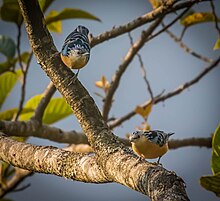| Beautiful nuthatch | |
|---|---|

| |
| A pair of beautiful nuthatches in Bhutan | |
| Scientific classification | |
| Domain: | Eukaryota |
| Kingdom: | Animalia |
| Phylum: | Chordata |
| Class: | Aves |
| Order: | Passeriformes |
| Family: | Sittidae |
| Genus: | Sitta |
| Species: | S. formosa
|
| Binomial name | |
| Sitta formosa Blyth, 1843
| |

| |
| Synonyms[2] | |
|
• Callisitta formosa (Blyth, 1943) | |
The beautiful nuthatch (Sitta formosa) is a bird species in the family Sittidae, collectively known as nuthatches. It is a large nuthatch, measuring 16.5 cm (6.5 in) in length, that is not sexually dimorphic. Its coloration and markings are dramatic, the upper parts being black and azure, streaked with white and pale blue on the head and lined with the same colors on the wing feathers. The underparts are orange, and the eyebrow and throat are ochre. An irregular, dark eyestripe highlights its eye. S. formosa's ecology is not fully described, but it is known to feed on small insects and larvae found on the trunks and epiphyte-covered branches of trees in its range. Reproduction takes place from April to May; the nest is placed in the hole of an oak, rhododendron, or other large tree. The nest is made of plant material and fur in which the bird typically lays four to six eggs.
Although the species is found in most of the countries making up the mainland of Southeast Asia, it appears to be rare throughout its range, its population being highly localized where it is found. The bird nests predominantly in montane forest at an altitudinal range from 950 m (3,120 ft) up to nearly 2,300 m (7,500 ft), with some seasonal height adjustment, down to around 300 m (980 ft) in winter. Its apparent localization within its range makes rigorous estimates of its population difficult, but its habitat is threatened by deforestation and the species appears to be in decline. It has been classified as vulnerable by the International Union for Conservation of Nature.
- ^ BirdLife International (2020). "Sitta formosa". IUCN Red List of Threatened Species. 2020: e.T22711231A177623642. doi:10.2305/IUCN.UK.2020-3.RLTS.T22711231A177623642.en. Retrieved 19 November 2021.
- ^ Dickinson, Edward C.; Loskot, Edward C.; Loskot, Vladimir M.; Morioka, Hiroyuki; Somadikarta, Soekarja (2000). "Systematic notes on Asian birds. 66. Types of the Sittidae and Certhiidae". Zoologische Mededelingen (80): 287–310.
